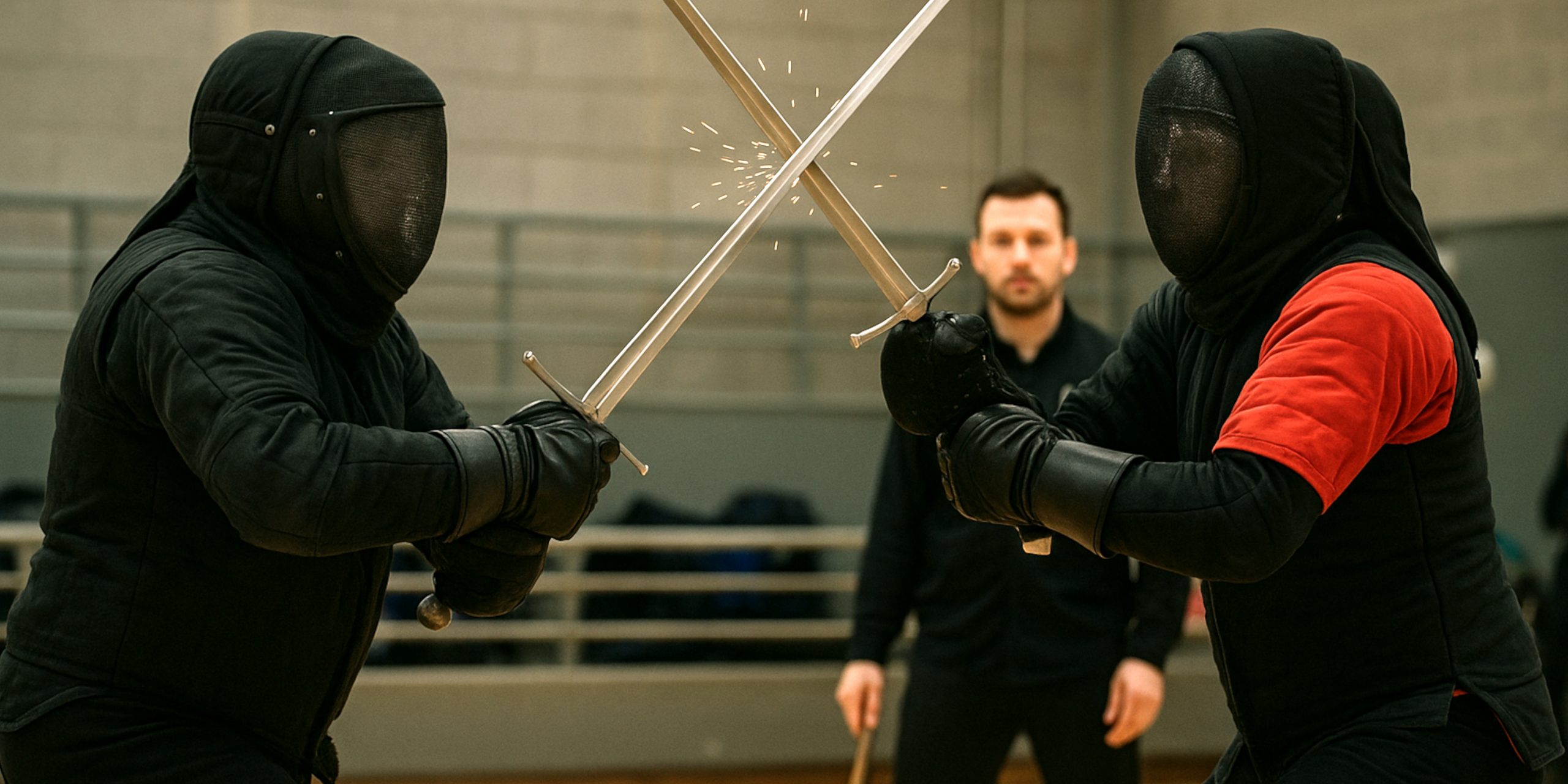
Modern Historical European Martial Arts, or HEMA, is one of those rare pursuits where grown adults get to whack each other with swords and call it education. Beneath the theatrical surface lies a serious martial discipline grounded in the surviving manuals of masters like Fiore dei Liberi, Joachim Meyer, and George Silver.
HEMA tournaments exist to test the practical application of those teachings, balancing authenticity with safety. Understanding how they work reveals a fascinating hybrid of historical research, sport fencing structure, and medieval flair.
Weapons and Divisions
Tournaments are divided by weapon type, experience level, and sometimes by ruleset or equipment class.
Main Weapon Divisions:
- Longsword: The most popular, drawing on 14th–16th century German and Italian schools.
- Rapier: Emphasises thrusts, footwork, and control, influenced by masters like Capo Ferro.
- Sabre: Fast-paced, cut-oriented, rooted in 18th–19th century military practice.
- Sword and Buckler: Compact, tactical, and historically based on I.33.
- Smallsword and Sidesword: Elegant weapons favouring finesse and precision.
Some events also include polearms, dagger, wrestling (Ringen), or armoured combat categories, though these are often demonstration or specialist formats.
Protective Gear and Safety
HEMA’s motto could well be: hit hard, not hospital.
Standard protective equipment includes:
- Fencing mask with back-of-head protection
- Heavy padded jacket
- Gorget and throat guard
- Forearm guards, gloves, and elbow protection
- Knee, groin, and optional chest protection
- Feder or blunt steel weapon, depending on category
Gear inspections are mandatory. Damaged or modified gear is prohibited. Historical accuracy is important, but safety always wins over authenticity.
Rules and Match Structure
The structure is similar to many martial sports but flavoured with historical context.
Common format:
- Pools: Round-robin matches to determine seeding.
- Eliminations: Top fighters progress to direct knockouts.
- Finals: Decided under close judging and, often, roaring crowds of historians.
Match time: 60–120 seconds of active fighting.
Victory condition: Highest score at time limit, or reaching target score (often 10–15 points).
Scoring and Afterblow System
HEMA’s scoring balances realism with safety. The afterblow rule, where a counter-hit after landing a strike reduces score value, is intended to simulate the risk of mutual injury.
Typical scoring breakdown:
| Action | Points | Notes |
|---|---|---|
| Clean hit (head/torso) | 2–3 | Strong, clear strike |
| Partial hit or limb | 1 | Reduced control or accuracy |
| Afterblow | -1 | Counter-hit within time window |
| Double hit | 0 (or penalty) | Mutual exchange, both lose |
Referees call halts after perceived hits, while judges signal what they observed. Points are tallied by table officials, sometimes aided by video replay for finals.
Judges and Officials
Each bout typically includes:
- Referee (Director): Manages the fight, ensures rules and safety.
- Corner Judges: Observe hits from multiple angles.
- Scorekeeper: Records scores and penalties.
- Timekeeper: Manages match duration.
Even with multiple officials, interpretation remains a delicate art. Fighters joke that arguing with judges is part of HEMA’s long tradition of treatise commentary.
Penalties and Conduct
HEMA emphasises controlled, honourable combat.
Common infractions:
- Striking after “halt”
- Unsafe grappling or uncontrolled thrusts
- Ignoring referee orders
- Equipment failure mid-bout
Infractions result in warnings, point deductions, or disqualification. The intent is to preserve both safety and the martial dignity of the event.
Comparison of Major HEMA Rulesets
| Ruleset / Event | Region / Organisation | Scoring System | Afterblow Handling | Notable Features |
|---|---|---|---|---|
| HEMA Ratings Standard | International (online standard) | 1–3 points per hit | Partial reduction | Used widely for ranking and record-keeping |
| Swordfish (Sweden) | Gothenburg Historical Fencing Open | 2–3 points | Reduces lead | Focus on clean technique and audience presentation |
| Longpoint (USA) | HEMA Alliance-affiliated | Weighted by hit quality | -1 or half-value | Incorporates athletic and tactical judging |
| Dreynevent (Austria) | European circuit | 2–3 points | 50% deduction | Emphasises historical realism and interpretation |
| Fechtschule America | North America | 1–3 points | Deducted only if clear counter | Uses hybrid rules inspired by period fechtschulen |
| By the Sword (UK) | UK Women’s HEMA event | 1–3 points | Full deduction | Promotes inclusivity and community engagement |
Each tournament adjusts timing windows, calibration of hits, and judge requirements slightly, but the general aim remains constant: reward historically accurate, controlled, and technically proficient fencing.
Tournament Atmosphere
HEMA events blend sport, scholarship, and spectacle. Between matches, competitors discuss manuscripts and compare bruises with academic detachment.
The camaraderie is genuine, the competition fierce, and the post-match pub debates often more animated than the finals.
Even the most serious tournaments maintain a spirit of playfulness. After all, everyone there has voluntarily paid to re-enact centuries-old sword fights in a sports hall.
Legacy and Purpose
HEMA tournaments are not about proving who would win a medieval duel. They exist to preserve, test, and refine the interpretations of martial masters whose work would otherwise remain static ink on parchment.
Each event is both a contest and a conversation, a blend of scholarship, swordsmanship, and spirited debate. The outcome matters less than the collective effort to bring the art back to life, one well-judged cut at a time.
The Seven Swords Takeaway
HEMA tournaments are where history and humanity collide, quite literally. They transform dusty manuscripts into living, breathing action.
For the historian, they’re a field experiment. For the fighter, a proving ground. For the spectator, an oddly satisfying blend of violence and vocabulary.
And for everyone involved, there’s the same shared truth: no spreadsheet or theory will ever replace the lesson learned from a well-aimed strike to the mask.



